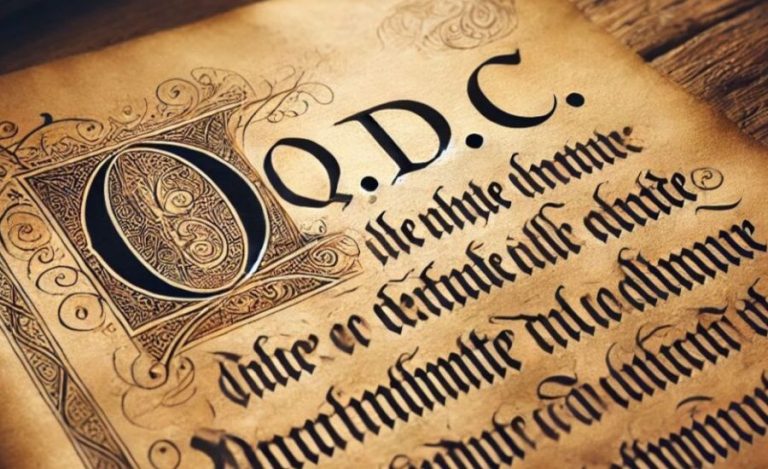Q.D.C. Old English Abbreviation: A Comprehensive Exploration

The abbreviation “Q.D.C. Old English Abbreviation” is a fascinating remnant of history that provides insight into the linguistic and cultural practices of Old English and medieval societies. Understanding its origins and applications sheds light on the role of language in religious, legal, and scholarly traditions. This article delves into the meaning, historical significance, and continued relevance of this intriguing abbreviation.
What Does Q.D.C. Old English Abbreviation Mean?
The “Q.D.C.” abbreviation is believed to originate from the Latin phrase Quod Deus Conjunxit, which translates to “What God has joined.” This phrase has strong religious connotations, often associated with sacred unions, particularly in the context of marriage.
The use of such abbreviations was common in legal and religious documents during the medieval period. By invoking divine authority, phrases like Quod Deus Conjunxit emphasized the sanctity and permanence of agreements or relationships, especially when formalized in a legal or ecclesiastical setting.
The Historical Significance of Q.D.C.
1. Religious Usage
In the medieval and Old English periods, the church played a central role in governance and societal norms. Latin was the language of the clergy and intellectual elite, and phrases such as “Q.D.C.” were frequently used in religious contexts. It was often inscribed on marriage certificates or religious decrees, symbolizing the divine authority that bound individuals or agreements.
2. Legal and Scholarly Applications
Beyond religious ceremonies, “Q.D.C. Old English Abbreviation” appeared in legal documents and manuscripts. Abbreviations like these were practical solutions to the limitations of parchment and paper, which were scarce and expensive. They also streamlined the writing process, enabling scribes to record complex ideas quickly while maintaining the authority of the written word.
3. Linguistic Evolution
The use of Latin abbreviations in Old English highlights the influence of Roman culture on the Anglo-Saxon world. During this period, Latin was the primary language for academic and ecclesiastical communication, blending seamlessly with the emerging Old English language. This fusion of linguistic traditions left a lasting legacy, with many abbreviations persisting into early modern English.
Symbolism in the Q.D.C. Abbreviation
The phrase “Quod Deus Conjunxit” embodies the medieval worldview, where divine authority underpinned human actions. The abbreviation’s use in legal and religious texts served as a constant reminder of moral obligations and the sacred nature of certain bonds.
In marriage, for example, the phrase reinforced the idea that unions were irrevocable, as they were sanctioned by God. Similarly, its appearance in legal contracts or decrees underscored the moral and spiritual weight of such agreements.
Modern Interpretations of Q.D.C. Old English Abbreviation
While the use of “Q.D.C.” has largely disappeared from contemporary texts, it remains a point of interest for historians, linguists, and those studying medieval culture.
- Academic Research: Scholars examining medieval manuscripts often encounter “Q.D.C.” and similar abbreviations. Understanding these terms is crucial for interpreting historical texts accurately.
- Cultural Relevance: The phrase serves as a reminder of the interplay between language, religion, and governance in shaping societal norms.
In modern times, the phrase Quod Deus Conjunxit is still echoed in certain Christian marriage ceremonies, reflecting its enduring spiritual significance.
Why Study Q.D.C. Old English Abbreviation?
Exploring the “Q.D.C. Old English Abbreviation” provides valuable insights into the past. Here’s why it remains relevant:
- Cultural Heritage: It highlights the interconnectedness of language, religion, and law in medieval societies.
- Linguistic Evolution: It showcases the transition from Latin-dominated texts to Old English and beyond.
- Historical Context: Understanding abbreviations like “Q.D.C.” helps us decode historical manuscripts and legal documents more effectively.
Conclusion
The “Q.D.C. Old English Abbreviation” is more than just a linguistic curiosity. It represents a pivotal era when religion, law, and language were deeply intertwined. For anyone studying medieval history, legal traditions, or linguistic evolution, this abbreviation offers a glimpse into how societies of the past communicated complex ideas with brevity and authority.
As we uncover more about these historical abbreviations, we gain a deeper appreciation for the ingenuity and cultural richness of those who used them centuries ago. The legacy of “Q.D.C.” lives on, not just in historical texts, but in our continued fascination with the ways language shapes and reflects human experience.



